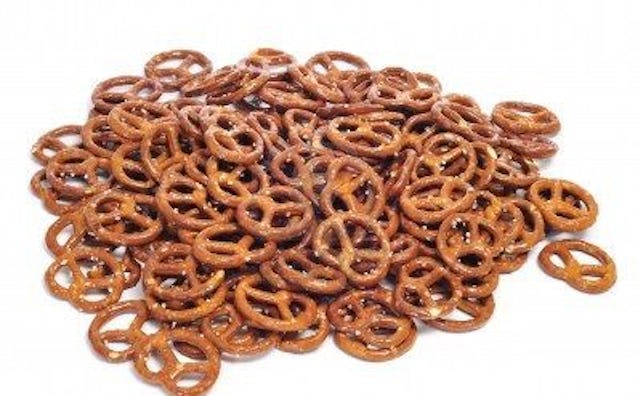Going Gluten-Free (Kind of)

Oh, how I savored that pretzel and it’s crunchy salty goodness, all the while promising myself, I’ll just have this one. But seconds later, somehow the contents of the bag were all gone. Good Lord, what was wrong with me? How could I have been so weak?
Not even a month had passed since my fourteen-year-old daughter was diagnosed with Celiac Disease, the autoimmune disorder that attacks one’s own digestive system if even specks of wheat, rye, or barley are consumed. Samantha’s lengthy illness had been a mystery, so when we finally found out the cause and the straightforward remedy (maintaining a gluten-free diet) we were quite relieved.
We didn’t bat an eye when her doctor said that to prevent cross-contamination and to be supportive, our entire household should also go gluten-free. Of course, we’d do whatever it takes to help Samantha feel better again.
I knew I wouldn’t have a problem going gluten-free. Parents are used to sacrificing for their children and, besides, I had been pregnant three times and never had a problem giving up my sushi, coffee or wine (well, you know, within reason).
My husband embraced the change, hoping that he too might feel better without all those carbs. My two other daughters were equally supportive, especially when they realized that they could still eat many of their favorite foods like steak, baked potatoes, nachos, and ice cream.
For the first couple weeks of our diet we ate like kings, as my talented cook husband whipped up naturally gluten-free meals like enchiladas, barbecued ribs, and stir-fry with rice. Next he tackled cooking with gluten-free pastas and flours, all with surprising results. “Wow, this takes almost like the real thing,” we would say, genuinely amazed that gluten-free foods could be so delicious.
I maintained my gluten-free diligence even when out of the house or at work. After all, Samantha couldn’t choose when and where to follow the diet, nor should I.
But then, the hunger came; the insatiable, unquenchable hunger. Because no matter how much gluten-free food I ate, it never felt like enough. As I lay in bed at night, my wheat-deprived belly ached. There was a constant gnawing in my stomach like something was missing, something that was filling and warm and doughy. Something like, oh, I don’t know, perhaps BREAD?
Because eating those gluten-free foods was like eating food from a parallel universe—they looked like regular food and for the first few bites they even tasted like it too, but by bite four they tasted too sugary or too powdery or just too odd to make you want to eat a large serving. Frankly at six bucks for a bag of gluten-free pasta or gluten-free cookies, who could even afford to eat enough to be satisfied?
Though my family and I said that the gluten-free substitutes were good, they weren’t really. It’s just that we were all so damn hungry. They were only “good” in the way that if you’d been stuck on a deserted island for six months eating nothing but insects and perhaps these were the first foods someone gave you upon being rescued. Then yes, they’d be good.
Naturally, I kept my unhappiness about the gluten-free diet to myself. But I soon found out that I was not alone. I noticed that my nine-year-old started accepting unusual invitations. “Really, you want to go Abby’s younger brother’s T-ball game?”
“Abby said we’d get pizza after. I’m sorry mom, but I gotta get some gluten. I need it something bad,” my youngest admitted.
Then I realized that my seventeen-year-old had missed her fifth dinner at home in as many nights. “Why are your study groups always at dinner time? You’re not going from house to house in search of gluten are you?”
“No, no, of course not,” she answered, eyes cast down. “All right, yes, I can’t help it. That gluten-free food is like eating air. I’m just so hungry all the time!” she confessed.
Obviously my eldest and youngest daughters shared more than our brown eyes, we were weak-willed bread-aholics as well.
Then at work I broke down and had those delicious pretzels. Really, I wouldn’t have done it had there been some gluten-free choices. I swear. As I ate those crunchy bad boys I just wished I wasn’t at work so I could have washed ‘em down with a hearty stout. Apparently pretzels were my gluten gateway drug.
But the joy I felt eating them quickly turned to guilt. What kind of horrible mother was I that I couldn’t even last a month without wheat for the sake of my daughter’s health? Was I some kind of gluten-addict?
I debated confessing my lapse to Samantha while we waited in line at the local hamburger joint. As I prepared to order two “protein burgers” (wrapped in lettuce instead of a bun) Samantha asked why I didn’t just order myself a regular burger instead.
“Because we’ve gone gluten-free, and I’m trying to be supportive. Really, you wouldn’t mind?”
“No. It doesn’t bother me when people eat gluten in front of me. In fact, I think it’s annoying when they don’t eat it because of me,” she said.
“You’re sure? You’re not just saying that and then later you’ll write in your memoirs about how horrible I was?”
“No, I’m not you.”
Ouch.
Well, I ate my burger, bun and all, and damn if it wasn’t the tastiest thing ever. As I finished, I looked at my daughter with admiration. She had handled her diagnosis and this whole gluten-free thing amazingly well, especially considering her age. Now, here she was generously telling me to enjoy my gluten-filled food.
If she turned out this great, maybe I wasn’t such a bad mother after all.
Or maybe that’s just the addiction talking.
This article was originally published on